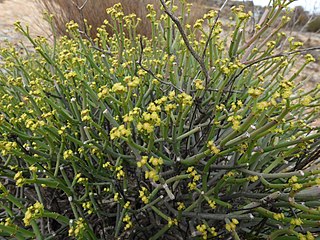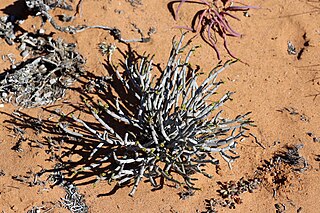
Agapanthus africanus, or the African lily, is a flowering plant from the genus Agapanthus found only on rocky sandstone slopes of the winter rainfall fynbos from the Cape Peninsula to Swellendam. It is also known as the lily-of-the-Nile in spite of only occurring in South Africa.

Kirstenbosch is an important botanical garden nestled at the eastern foot of Table Mountain in Cape Town. The garden is one of 10 National Botanical Gardens covering five of South Africa's six different biomes and administered by the South African National Biodiversity Institute (SANBI). Prior to 1 September 2004, the institute was known as the National Botanical Institute.
Lachnospermum, common name rooiblombos, is a genus of South African flowering plants in the family Asteraceae.

Euphorbia caput-medusae is a plant of the genus Euphorbia that occurs in and around Cape Town, South Africa.

The Karoo Desert National Botanical Garden is a botanical garden focused on succulents and other plants of arid regions, that lies at the foot of the Hex River Mountains range, in the town of Worcester, South Africa.

Smilax anceps is a vigorous scrambling vine or shrub, and is one of some 278 species in the genus Smilax in the family Smilacaceae. The species is widespread in Tropical Africa, Southern Africa, Réunion, Mauritius, Comoros, and Madagascar. The specific name 'anceps' is Latin for 'dangerous', a caution against the hooked prickles. Tarundia cinctipennis Stål, 1862, a hemipteran insect, is associated with this plant.

Euphorbia rowlandii, the Levuvhu euphorbia, is a succulent member of the spurge family native to the Soutpansberg region in South Africa, and southeastern Zimbabwe. It is a medium-sized, monoecious shrub with multiple spiny blue-green photosynthetic stems. The species is superficially similar to E. waterbergensis, and is named after the Levubu River.
The South African National Biodiversity Institute (SANBI) is an organisation tasked with research and dissemination of information on biodiversity, and legally mandated to contribute to the management of the country's biodiversity resources.

Daubenya zeyheri (Kunth) J.C.Manning & A.M.van der Merwe is one of 8 bulbous species in the genus, all endemic to the winter rainfall Strandveld of South Africa, and mostly growing on doleritic clays along the West Coast, Western Cape. It is closely related to Daubenya marginata J.C.Manning & A.M.van der Merwe. At first believed to consist of a single species, Daubenya aurea, the genus was expanded in 2000 to include the genera Androsiphon and Amphisiphon and various species that had previously been classified as Polyxena, Massonia, or Neobakeria. "The poor congruence between morphological and other characters within Hyacinthaceae has also made generic circumscriptions very difficult. One of the consequences of this has been the recognition of a large number of genera that are poorly defined morphologically." - All 8 species have two spreading, prostrate leaves and tubular flowers that range from white to yellow or red, and in 6 of the species are followed by smooth glossy seeds within papery capsules that lend themselves to anemochory or wind dispersal. The inflorescence is produced at ground level on a sub-surface peduncle between the two leaves. Species are variously pollinated by bees, butterflies, moths, the monkey beetle Lepisia glenlyonensis and sunbirds. The water-retaining nature of doleritic clays ensures their remaining moist for longer than clays formed from shales of the Karoo series. Exceptionally D. namaquensis is found in deep red sands and D. zeyheri in calcareous coastal sands.

Euphorbia clavarioides, lion's spoor, anthill euphorbia, is a species of herbaceous plant in the family Euphorbiaceae. It is native to Botswana, Lesotho, and South Africa. It may grow to 18 cm in diameter, with a height of 30 cm. Its flowers are yellow.

Cyrtanthus ventricosus, commonly called fire lilly, is a small deciduous, bulbous plant reaching a height of 100–250 mm (3.9–9.8 in). It is in the amaryllis family, Amaryllidaceae, and is found along the Cape Fold Mountains from the Cape Peninsula, Western Cape, to the Kouga Mountains, Eastern Cape in South Africa.

Euphorbia tuberosa, commonly known as '"milkball/melkbol"' or '"wilderamenas"', is a variable geophytic plant of the family Euphorbiaceae, indigenous to the western parts of South Africa.
Euphorbia tenax is a species of Euphorbia endemic to South Africa, where it occurs in the Northern Cape and Western Cape provinces, around Kotzesrus and southwards as far as Nieuwoudtville and Cape Town. Its preferred habitat is sand Fynbos and Succulent Karoo on shale-derived slopes.

Euphorbia rhombifolia is a species of flowering plant in the Euphorbiaceae family. It is native to Namibia and South Africa, where it is widespread in clay-rich soils, extending as far east as Kwazulu-Natal.

Euphorbia burmannii is a species of Euphorbia indigenous to Namibia and South Africa, where it is widespread in sandy soils, extending southwards to the Cape Peninsula and as far east as Grahamstown.
The Baynes Mountains are a mountain range in Namibia.

Euphorbia mauritanica, commonly known as yellow milk bush or golden spurge, is a species of plant in the family Euphorbiaceae native to Africa.

Serruria stellata, the star spiderhead, is a flower-bearing shrub that belongs to the genus Serruria and forms part of the fynbos. The plant is native to the Western Cape, South Africa.

Helichrysum retortum, the flask everlasting or sea strawflower, is a species of plant from South Africa.















